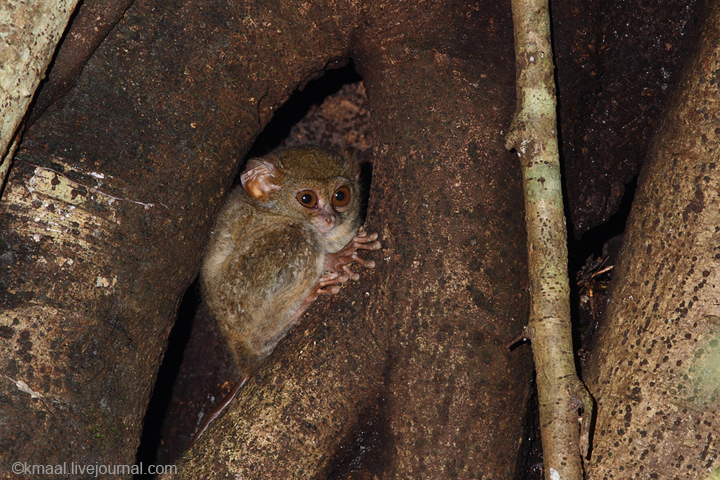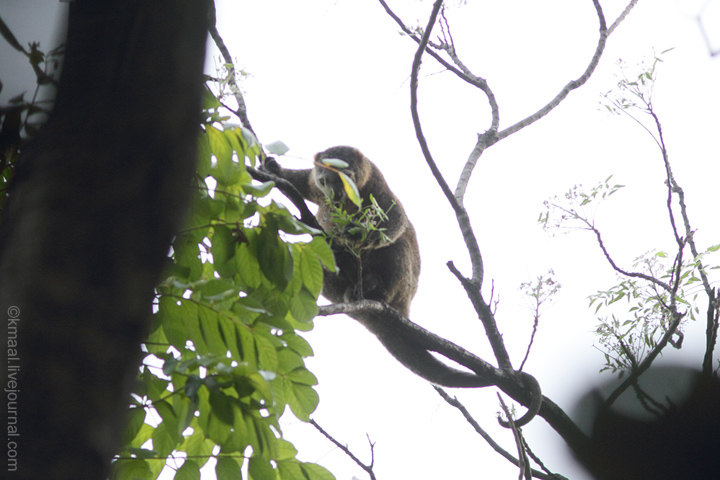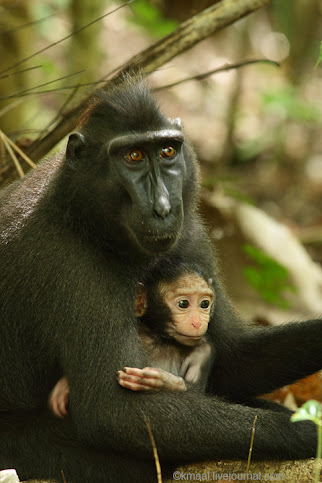Tangkoko - 1
Вход в заповедник Тангкоко-Батуангус Дуа Саудара находится в деревне Батупутих, часах в двух пути от Манадо. Общественный траспорт здесь - грузовички с деревянными лавками поперек кузова. Тент от дождя закреплен только на кабине, а по бокам его держат руками. На таком грузовичке я и приехал в середине дня и выгрузился у хоумстея "Тарсиус" почти прямо напротив мостика, ведущего в заповедник. Там же сразу и договорился на утреннюю экскурсию. Начало в 4:30, сразу чувствуется правильный подход - здесь светает в 5, и чтобы застать долгопятов (Tarsius tarsier) еще бодрствующими, нужно придти вовремя.
The entrance to Tangkoko-Batuangus Dua Saudara nature reserve is in Batuputih village about two hours from Manado. The public transport here is a small truck with wooden benches across the box. The rain cover is fixed only to the cabin, and the passengers hold the sides with their hands. On such a vehicle I arrived to Batuputih in the middle of the day, and subscribed to a jungle walk in the morning. It starts at 4:30 a.m., you see the right approach immediately. The dawn comes at 5 a.m., and to see the tarsiers (Tarsius tarsier) awake, you need to come on time.
Долгопяты утром собираются на отдых в переплетениях стволов фикусов-душителей Ficus benjamina, оставивших дупла на месте сгнившего дерева-опоры. Часов в 5-6 долгопяты еще сидят снаружи, потом перебираются в более укромные места. Мы видели несколько групп долгопятов, но похоже все они были довольно сытыми, только пару раз удалось увидеть прыжок на добычу - кузнечика, принесенного гидом.
They gather to rest between the trunks of the strangling figs Ficus benjamina, which leave a hollow in the place of the dead master tree. Around 5 or 6 you still find the tarsiers on the outside, later they go deeper between the trunks. We saw several groups of tarsiers, and all appeared not hungry, only a couple of times could we see a leap of a tarsier for its prey - a catydid brought by the guide.

Медвежьего кускуса (Ailurops ursinus), говорят, обычно трудно увидеть среди листвы, когда он кормится в верхней части кроны. Но нам повезло - дерево было почти голым, и видимость настолько хорошей, насколько это возможно в лесу, и кускуса было три.
Кускусы тоже иногда поглядывали на нас.
They say that it usually difficult to see the Sulawesi bear cuscus (Ailurops ursinus) behind the green branches when it feeds on high trees. But we had luck - the tree was almost bare and the visibility nearly as good as it can be in a forest. And there were three cuscuses. They looked at us too, sometimes.

Сулавесский калао (Aceros cassidix).
Knobbed hornbill (Aceros cassidix)

Мне очень понравились черные макаки (Macaca nigra). В заповеднике они не боятся людей, но и не проявляют к ним нездорового интереса, вообще за ними очень приятно наблюдать. О них отдельный пост.
I liked a lot the Celebes crested macaques (Macaca nigra). In the reserve they are not afraid of humans but also not too much interested in them. It is a pleasure to observe them. A post on the black macaques follows.


А сейчас я на гнездовой площадке малео в национальном парке Богани Нини Вартабоне. Жду малео, но их сегодня пока не видно.
And now I am on the maleo nesting ground in the Bogani Nani Wartabone National Park. Waiting for maleo, but still no sighting today.